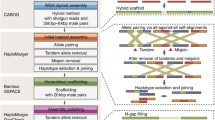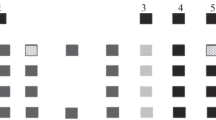Abstract
Cow stomach lysozyme genes have evolved in a mosaic pattern. The majority of the intronic and flanking sequences show an amount of sequence difference consistent with divergent evolution since duplication of the genes 40–50 million years ago. In contrast, exons 1, 2, and 4 and immediately adjacent intronic sequences differ little between genes and show evidence of recent concerted evolution. Exon 3 appears to be evolving divergently. The three characterized genes vary from 5.6 to 7.9 kilobases in length. Different distributions of repetitive DNA are found in each gene, which accounts for the majority of length differences between genes. The different distributions of repetitive DNA in each gene suggest the repetitive elements were inserted into each gene after the duplications that give rise to these three genes and provide additional support for divergent evolution for the majority of each gene. The observation that intronic and flanking sequences are evolving divergently suggests that the concerted evolution events involved in homogenizing the coding regions of lysozyme genes involve only one exon at a time. This model of concerted evolution would allow the shuffling of exon-sized pieces of information between genes, a phenomenon that may have aided in the early adaptive evolution of stomach lysozyme.
Similar content being viewed by others
References
Benton WD, Davis RW (1977) Screening λgt recombinant clones by hybridization to single plaques in situ. Science 196:180–182
Bilofsky HS, Burks C (1988) The GenBank® genetic sequence data bank. Nucleic Acids Res 16:1861–1863
Bonifer C, Vidal M, Grosveld F, Sippel AE (1990) Tissue specific and position independent expression of the complete gene domain for chicken lysozyme in transgenic mice. EMBO J 9:2843–2848
Castañón MJ, Spevak W, Adolf GR, Chlebowicz-Śledziewska E, Śledziewski A (1988) Cloning of human lysozyme gene and expression in the yeast Saccharomyces cerevisiae. Gene 66: 223–234
Chung LP, Keshav S, Gordon S (1988) Cloning the human lysozyme cDNA. Proc Natl Acad Sci USA 85:6227–6231
Cortopassi GA, Wilson AC (1990) Recent origin of the P lysozyme gene in mice. Nucleic Acids Res 18:1911
Cortopassi GA, Wilson AC (1991) Genetic analysis of a switch in cell specificity of P lysozyme expression in molossinus mice. Genet Res 58:111–114
Cross M, Renkawitz R (1990) Repetitive sequence involvement in the duplication and divergence of mouse lysozyme genes. EMBO J 9:1283–1288
Cross M, Mangelsdorf I, Wedel A, Renkawitz R (1988) Mouse lysozyme M gene. Proc Natl Acad Sci USA 85:6232–6236
Dobson DE, Prager EM, Wilson AC (1984) Stomach lysozymes of ruminants. I. Distribution and catalytic properties. J Biol Chem 259:11607–11616
Duncan CH (1987) Novel Alu-type repeat in artiodactyls. Nucleic Acids Res 15:1340
Elgin SCR (1988) The formation and function of DNase I hypersensitive sites in the process of gene activation. J Biol Chem 263:19259–19262
Elgin SCR (1990) Chromatin structure and gene activity. Curr Opin Cell Biol 2:437–445
Ellis NA, Goodfellow PJ, Pym B, Smith M, Palmer M, Frischauf A-M, Goodfellow PN (1989) The pseudoautosomal boundary in man is defined by an AN repeat sequence inserted on the Y chromosome. Nature 337:81–84
Ellis N, Yen P, Neiswanger K, Shapiro LJ, Goodfellow PN (1990) Evolution of the pseudoautosomal boundary in Old-World monkeys and great apes. Cell 63:977–986
Feinberg AP, Vogelstein B (1983) A technique for radiolabeling DNA restriction endonuclease fragments to high specific activity. Anal Biochem 132:6–13
Frischauf A-M (1987) Construction and characterization of a genomic library. Methods Enzymol 152:190–199
Hammer MF, Schilling JW, Prager EM, Wilson AC (1987) Recruitment of lysozyme as a major enzyme in the mouse gut: duplication, divergence, and regulatory evolution. J Mol Evol 24:272–279
Henikoff S (1984) Unidirectional digestion with Exonuclease III creates targeted breakpoints for DNA sequencing. Gene 28: 351–359
Irwin DM, Wilson AC (1989) Multiple cDNA sequences and the evolution of bovine stomach lysozyme. J Biol Chem 264: 11387–11393
Irwin DM, Wilson AC (1990) Concerted evolution of ruminant stomach lysozymes. Characterization of cDNA clones from sheep and deer. J Biol Chem 265:4944–4952
Irwin DM, Sidow A, White RT, Wilson AC (1989) Multiple genes for ruminant lysozymes. In: Smith-Gill SJ, Sercarz EE (eds) The immune response to structurally defined proteins: the lysozyme model. Adenine Press, Schenectady NY, pp 73–85
Irwin DM, Kocher TD, Wilson AC (1991) Evolution of the cytochrome b gene of mammals. J Mol Evol 32:128–144
Irwin DM, Prager EM, Wilson AC (1992) Evolutionary genetics of ruminant lysozymes. Animal Genetics 23:193–202
Jollès P, Schoentgen F, Jollès J, Dobson DE, Prager EM, Wilson AC (1984) Stomach lysozymes of ruminants. II. Amino acid sequence of cow lysozyme 2 and immunological comparisons with other lysozymes. J Biol Chem 259:11617–11625
Jollès J, Jollbs P, Bowman BH, Prager EM., Stewart C-B, Wilson AC (1989) Episodic evolution in the stomach lysozymes of ruminants. J Mol Evol 28:528–535
Jollès J, Prager EM, Alnemri ES, Jolles P, Ibrahimi IM, Wilson AC (1990) Amino acid sequences of stomach and nonstomach lysozymes of ruminants. J Mol Evol 30:370–382
Kimura M (1980) A simple method for estimating evolutionary rates of base substitutions through comparative studies of nucleotide sequences. J Mol Evol 16:111–120
Kraus F, Miyamoto MM (1991) Rapid cladogenesis among the pecoran ruminants: evidence from mitochondrial DNA sequences. Syst Zool 40:117–130
Koop BF, Siemieniak D, Slightom JL, Goodman M, Dunbar J, Wright PC, Simons EL (1989) Tarsier δ- and β-globin genes. J Biol Chem 264:68–79
Li Q, Zhou B, Powers P, Enver T, Stamatoyannopoulos G (1991) Primary structure of the goat β-globin locus control region. Genomics 9:488–499
Li W-H, Wu C-I, Luo C-C (1985) A new method for estimating synonymous and nonsynonymous rates of nucleotide substitution considering the relative likelihood of nucleotide and codon changes. Mol Biol Evol 2:150–174
Li W-H, Tanimura M, Sharp PM (1987) An evaluation of the molecular clock hypothesis using mammalian DNA sequences. J Mol Evol 25:330–342
Mazan S, Bachellerie J-P (1990) Organization of the gene family encoding mouse U313 RNA: role of gene conversions in its concerted evolution. Gene 94:263–272
Mierendorf RC, Pfeffer D (1987) Direct sequencing of denatured plasmid DNA. Methods Enzymol 152:556–562
Peters CWB, Kruse U, Pollwein R, Grzeschik K-H, Sippel AE (1989) The human lysozyme gene. Eur J Biochem 182:507–516
Phi-Van L, von Kries JP, Ostertag W, Strätling WH (1990) The chicken lysozyme 5' matrix attachment region increases transcription from a heterologous promoter in heterologous cells and dampens position effects on the expression of transfected genes. Mol Cell Biol 10:2302–2307
Prieur DJ (1986) Tissue specific deficiency of lysozyme in ruminants. Comp Biochem Physiol 85B:349–353
Quentin Y (1988) The Alu family developed through successive waves of fixation closely connected with primate lineage history. J Mol Evol 27:194–202
Quentin Y (1989) Successive waves of fixation of B1 variants in rodent lineage history. J Mol Evol 28:299–305
Rogers JH (1985) The origin and evolution of retroposons. Int Rev Cytol 93:187–279
Saiki RK, Gelfand DH, Stoffel S, Scharf SJ, Higuchi R, Horn GT, Mullis KB, Erlich HA (1988) Primer-directed enzymatic amplification of DNA with a thermostable DNA polymerase. Science 239:487–491
Sambrook J, Fritsch EF, Maniatis T (1989) Molecular cloning, 2 ed. Cold Spring Harbor Laboratory Press, Cold Spring Harbor NY
Schimenti JC, Duncan CH (1984) Ruminant globin gene structures suggest an evolutionary role for Alu-type repeats. Nucleic Acids Res 12:1641–1655
Slagel V, Flemington E, Traina-Dorge V, Bradshaw H, Deininger P (1987) Clustering and subfamily relationships of the Alu family in the human genome. Mol Biol Evol 4:19–29
Soulier S, Mercier JC, Vilotte JL, Anderson J, Clark AJ, Provot C (1989) The bovine and ovine genomes contain multiple sequences homologous to the α-lactalbumin-encoding gene. Gene 83:331–338
Spence SE, Young RM, Garner KJ, Lingrel JB (1985) Localization and characterization of members of a family of repetitive sequences in the goat β-globin locus. Nucleic Acids Res 13: 2171–2186
Stewart C-B, Wilson AC (1987) Sequence convergence and functional adaptation of stomach lysozymes from foregut fermenters. Cold Spring Harbor Symp Quant Biol 52:891–899
Stewart C-B, Schilling JW, Wilson AC (1987) Adaptive evolution in the stomach lysozymes of foregut fermenters. Nature 330: 401–404
Stief A, Winter DM, Strätling WH, Sippel AE (1989) A nuclear DNA attachment element mediates elevated and position-independent gene activity. Nature 341:343–345
Swanson KW, Irwin DM, Wilson AC (1991) Stomach lysozyme gene of the langur monkey: tests for convergence and positive selection. J Mol Evol 33:418–425
Watanabe Y, Tsukada T, Notake M, Nakanishi S, Numa S (1982) Structural analysis of repetitive DNA sequences in the bovine corticotropin-β-lipotropin precursor gene region. Nucleic Acids Res 10:1459–1469
Weiner AM, Deininger PL, Efstratiadis A (1986) Nonviral retroposons: genes, pseudogenes, and transposable elements generated by the reverse flow of genetic information. Annu Rev Biochem 55:631–661
White FH Jr, McKenzie HA, Shaw DC, Pearce RJ (1988) Studies on a partially purified bovine milk lysozyme. Biochem Int 16:521–528
Yoshimura K, Toibana A, Nakahama K (1988) Human lysozyme: sequencing of a cDNA, and expression and secretion by Saccharomyces cerevisiae. Biochem Biophys Res Commun 150:794–801
Author information
Authors and Affiliations
Additional information
Deceased July 21, 1991
Correspondence to: D.M. Irwin
Rights and permissions
About this article
Cite this article
Irwin, D.M., White, R.T. & Wilson, A.C. Characterization of the cow stomach lysozyme genes: Repetitive DNA and concerted evolution. J Mol Evol 37, 355–366 (1993). https://doi.org/10.1007/BF00178866
Received:
Accepted:
Issue Date:
DOI: https://doi.org/10.1007/BF00178866




